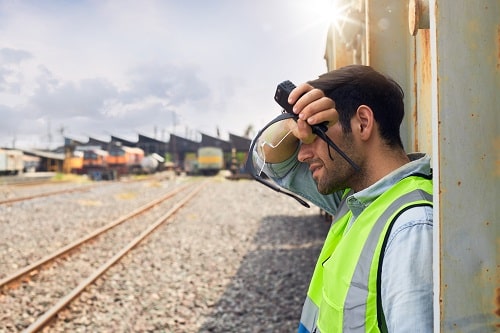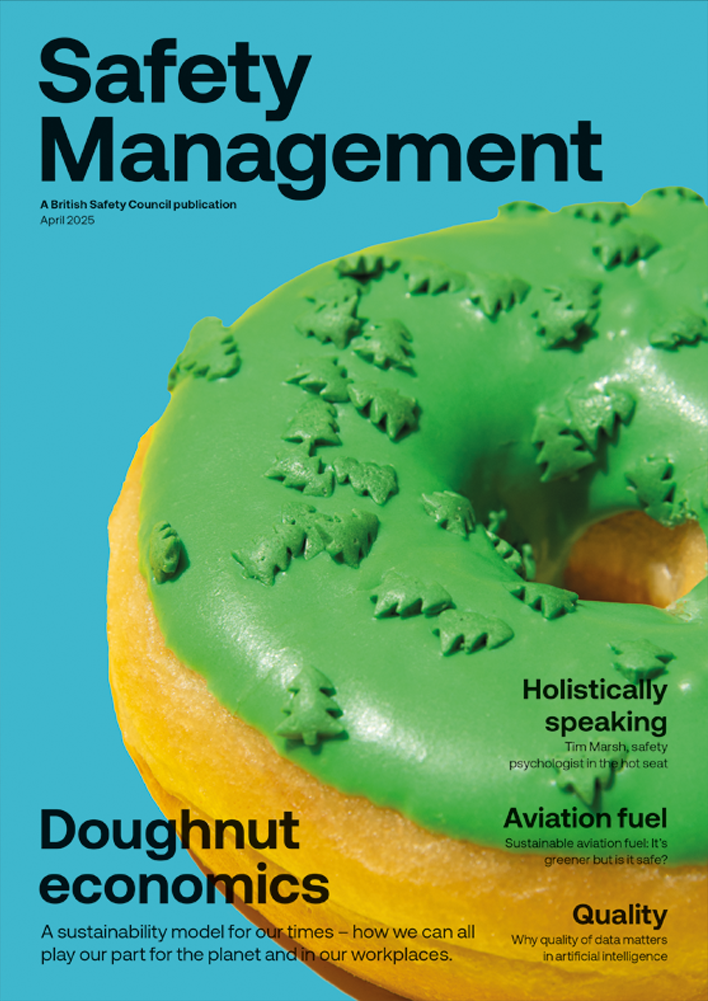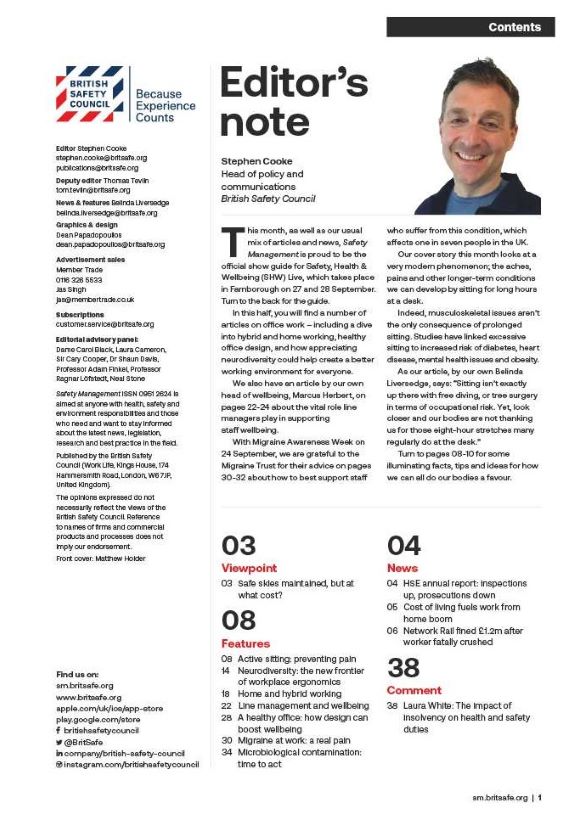As the proportion of older people in the workforce grows, it is vital employers take steps to assess and mitigate risks to the health, safety and wellbeing of older employees, such as a possible higher chance of musculoskeletal injury.
Opinion
An age diverse workforce – some key health and safety considerations
Workers aged 60 and over accounted for 34 per cent of those killed in work-related accidents in 2023/24, despite them making up only 11 per cent of the workforce, according to the Health and Safety Executive’s (HSE’s) recent statistics on workplace fatalities.
 Photograph: iStock/VioletaStoimenova
Photograph: iStock/VioletaStoimenova
HSE’s figures show that the rate of fatal injury increases with age. For example, the fatality rate for workers between the ages of 60 and 64 (per 100,000 workers) is almost twice the combined rate for workers across all ages. The fatality rate for workers aged 65 and over is almost four times higher than the all-age rate.
Higher incidence rate of non-fatal injury
There is conflicting research in respect of non-fatal injuries sustained by the older generation. However, the HSE reports¹ that per 100,000 employees, workers aged over 65 were more than twice as likely to experience non-fatal injury than those aged between 20 and 44. Additionally, older workers (defined by HSE as 55+), experienced more injuries that resulted in more than seven days' absence from work when compared with younger workers. The consensus also appears to be that for certain injuries – for example, musculoskeletal injuries – older workers are at significantly greater risk when compared to the overall average.
These statistics should be carefully considered by employers, particularly as the proportion of older people in the working population grows.
This increase is expected to mirror the general demographic trend. We have seen successive UK Governments mount a series of targeted campaigns to encourage older workers to remain in, or return to, the workplace, amid concerns about the consequences of economic inactivity. The value of experience is also increasingly being recognised by companies such as Hilton and EasyJet, who recently embarked on targeted recruitment drives aimed at attracting those aged over 50 to work for them.
Health and safety implications
An older working population can have implications for occupational health and safety. For example, some older workers may have had longer exposure to particular risks. For others, advancing years may bring with them changes in physicality and cognitive agility. Campaigns to encourage continued working into older age will only succeed if workers remain able, both physically and mentally, to actively participate in their workplace and perform the tasks assigned to them. This requires, among other things, measures to ensure continued occupational health.
The Health and Safety at Work etc. Act 1974 (HSWA) places a duty on employers to ensure the health and safety of workers and others affected by their work, regardless of their age, in-so-far as is reasonably practicable. This involves ongoing assessment and mitigation of risk, as well as the provision of suitable and sufficient training and supervision, regular reviews and encouragement of a culture of compliance.
There are no specific requirements in the HSWA or its associated regulations relating solely to older workers. In particular, there is no general requirement for an individual risk assessment of older workers. However, employers must ensure they are able to meet the needs of any specific worker or group of workers. This means that where there are identifiable risks associated with older workers, these must be assessed and mitigated in-so-far as reasonably practicable.
Of course, just because a worker reaches a particular age, this does not mean their ability to do their job declines, or they suddenly become more vulnerable to illness or injury. In fact, many older people are physically stronger and more mentally agile than their younger counterparts. There can be no one-size-fits-all approach to the occupational health and safety implications of ageing. Employers should focus on workers’ ability to meet the challenges of their role, and the work demands in themselves, rather than chronological age. However, appreciation of some of the specific changes generally associated with ageing will assist employers in carrying out their risk assessments.
Greater propensity to musculoskeletal injury
Statistics do suggest that older workers generally have a greater propensity for musculoskeletal injury. The deterioration of physical functioning is reported to be a common problem faced by older workers who are involved in physically demanding jobs, reducing work ability and affecting recovery rates. In addition, hearing and vision impairments, fatigue and chronic diseases (such as high blood pressure, cholesterol and lung disease) are also more commonly reported in older workers.
In any workplace, the measures that employers put in place to mitigate risk should be for the benefit of all workers. For example, employers should mitigate the risks of manual handling, put in place measures to ensure safety where pedestrians and vehicular traffic share the same space, as well as properly planning and supervising work at height for the benefit of all workers.
![]() Photograph: iStock/PixelsEffect
Photograph: iStock/PixelsEffect
However, where those carrying out work are older, employers should consider whether any specific measures are also required, such as to negate hearing loss or balance issues. In some instances, this may require adjustments, including a change to duties to match the physical ability of certain workers, and additional training. Measures to improve and preserve the health, as well as safety, of the general workforce should also be considered and tailored to the demographics. These may include access to occupational health services, medical assessments and other such supports.
Where new technology is being introduced, employers must provide proper communication, training and supervision as part of the overall assessment of the risks of that solution. Again, considerations should include the demographic of the relevant workers, with suitable adjustments made to training and supervision, where required. For some workers, young and old, the adaptation to new ways of working may take longer and require more targeted training to meet their level and speed of knowledge and understanding. In some cases, additional supervision may also be required.
In each case, employers must tailor the risk assessment to meet the relevant risks. Employers are used to doing this – it is simply another example of the need to properly consider the risks faced by employees and adjust working arrangements accordingly. The only unique thing is the range of conditions that age can signal. Understanding the range of changes which may be faced by older workers, as well as the protective factors which may improve the longevity of their useful working life, will be crucial for proper planning and consideration of risk.
Current thinking on particular physical and/or cognitive issues encountered as we age, and how to make adjustments for them, can help inform employers here. Examples include ensuring availability of occupational health services; redesigning/redeploying work and reducing physical work to match with older workers’ strength and energy; ensuring workstations are ergonomically designed to suit the needs of an older worker as required, etc. Guidance from HSE and relevant industry bodies should be considered.
Similarly, if an individual worker has any known vulnerabilities, suitable adjustments must be made to mitigate any risk they pose. These vulnerabilities will not necessarily relate to age (and often will not). For instance, Morrisons supermarket was recently fined over £3 million for breaching health and safety law after a worker with epilepsy died from injuries sustained after falling down a staircase. Morrisons knew of the worker’s condition and were held by the court to have failed to properly assess and mitigate the risks of the employee having an epileptic seizure when using the staircase to access his staff locker.
No one-size-fits-all approach
As the Morrisons case demonstrates, there can be no one-size-fits-all approach to risk assessments. They must be designed to meet any known vulnerabilities, whether in a particular worker, or group of workers. But even then, careful consideration is required. Although the workplace fatality statistics might give the impression of older workers as a generally more vulnerable group, those statistics do not necessarily tell the whole story. In fact, older workers are not more likely to die at work, but they are more likely to die from injuries sustained there. The statistics are another reminder of the need to ensure risk assessments are properly thought through, tailored to the risks encountered in the specific workplace, and its particular workers, and that suitable mitigations are put in place.
Adopting a one-size-fits-all approach at any of these stages will not be tolerated by the regulator who has made it clear they will hold those who fail to manage their risks to account. As the Morrisons case shows, failure can be very costly, not only in terms of human life, but financially and reputationally too.
Liam Jagger is an associate solicitor at Pinsent Masons LLP. Contact him at:
References
1. gov.uk/statistics/assets/docs/ridagegen.xlsx
OPINION

Heat at work: a silent killer
By Halshka Graczyk and Lacye Groening, ILO on 07 April 2025
Workers across the world are increasingly being exposed to excessive heat with serious implications for their safety and health. It is therefore vital that governments, employers and workers’ organisations develop, share and implement practical and low-cost strategies and measures for effectively reducing the risk from heat stress at work.

Making good work the foundation
By Mike Robinson FCA, British Safety Council on 07 April 2025
In 2024, for the first time, the UK dropped out of the list of the top 20 happiest countries: according to the World Happiness Index. This year, the UK rests in 23rd place, slightly ahead of the US and behind the Nordic countries, Germany, the UAE and others.

The air we share: why tackling pollution protects us all
By Scott Paul, Mums for Lungs on 04 April 2025
Air pollution is often invisible; its impact is anything but. Whether you’re a parent worried about your child’s lungs, a construction worker breathing exhaust fumes, or a commuter passing through busy streets, polluted air is everyone’s problem.



